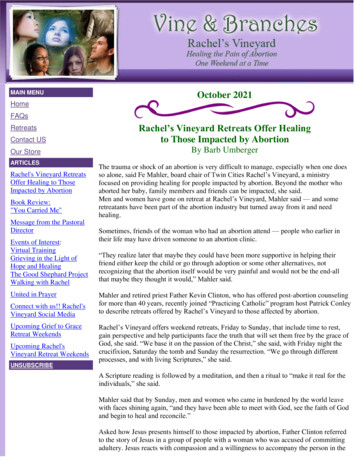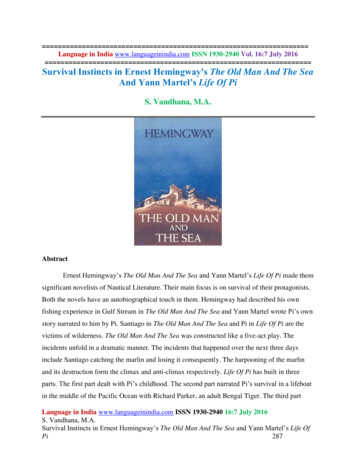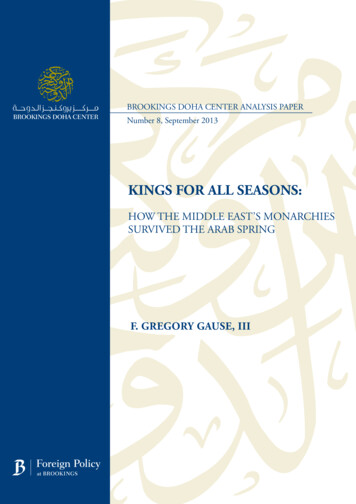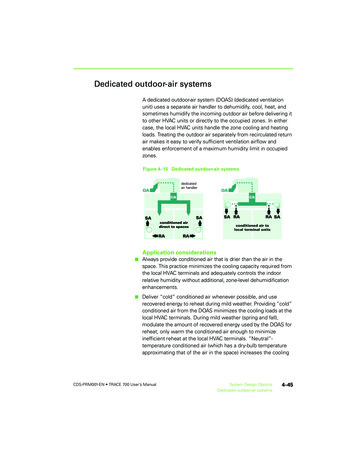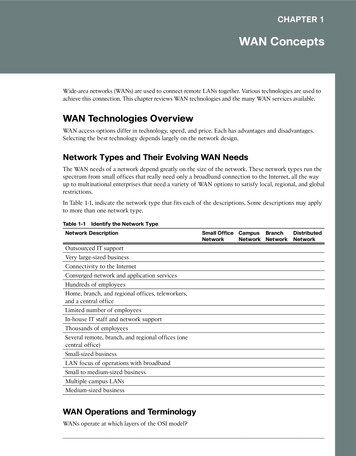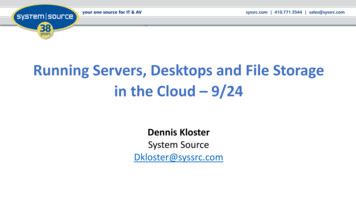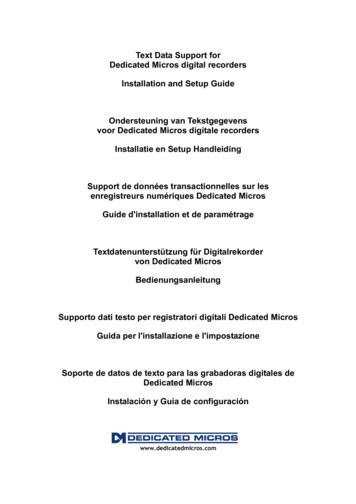
Transcription
Contents
ContentsDedicated to those who survived the atomic bombingsonly to suffer continued fear and anxiety because of the lasting danger from radiationMay the souls of the departed lie in peaceful reposeMay those still living and suffering be beacons shining brightly so that all humankindcan see the evil of nuclear weaponsCopyright 2007 by Nanao Kamada One Day in Hiroshima An Oral Historypublished by Japanese affiliate of IPPNW( International Physicians for the Prevention of Nuclear War )JPPNW c/o Hiroshima Prefectural Medical Association1-1-1Kanonhonmachi, Nishiku, Hiroshima 733-8540, JapanTel: 81 82 232 7211 Fax: 81 82 293 /default.htmE-mail: ippnw-japan@hiroshima.med.or.jp or onedayhiroshima@msn.comDesigned by Shift ProjectOriginally published in Japanese by Shift Project and Nanao Kamada, Hiroshima,2005
ContentsBy Nanao Kamada. M.DTranslation Editors Richard C. ParkerRick NelsonTranslators Keiko OguraYoshie OzakiMegumi ShimoMegumi MoritaNo part of this book maybe reproduced or utilized in any form or by any means,electronic or mechanical, including photocopying and recording, or by any informationstorage or retrieval system, without permission in writing from the publisher.ISBN978-4-9903680-0-5All rights reserved, 2007
ContentsForewordAlthough the dropping of the atomic bomb on Hiroshima andNagasaki was chosen in a national poll of American journalists inthe year 2000 as the top news story of the 20th century, not much isever said about what it is like for those who experienced andsurvived the attacks. Furthermore, those countries that now possessnuclear arms continually flaunt their overwhelming military powerand use the threat of their nuclear arsenals in order to maintain theireconomic advantage. Because the nuclear bomb is a weapon ofmass destruction with tremendous power to kill indiscriminately,much work needs to be done to limit their numbers and not allowother countries to develop their own.Having experienced the A-bombing and its suffering, Japan has amission to convey the reality of the damage caused by nuclearweapons and speak out strongly against them ever being usedagain. Atomic bombs have the capacity to not only kill masses ofpeople instantly, but they also emit radiation that destroys the genesof people who managed to survive the initial blast. Not only do thebombs cause physical harm, but they also are a source of cripplingfear and anxiety to the survivors for the rest of their lives.I wrote One Day in Hiroshima-An Oral History because althoughmost people are aware there are lingering after-effects fromradiation, few know that there are still survivors who continue tosuffer from second or third cancers because of radiation damage. Itis presented in three parts: “Past,” “Present” and “Future” withmany photos and technical explanations to help you get a betterunderstanding. It is an interview of an elderly woman who survivedthe bombing in Hiroshima and she answers various questions abouther life after the attack. Her experiences were shared by manyothers and I hope this book helps you to understand the actualsituation of the survivors. Unfortunately, she passed away before itwas published.It would be my greatest pleasure if this book contributes to peaceactivities by many people from all over the world. I hope itencourages you to start thinking about what you can do towardbuilding a more peaceful world without nuclear weapons.At present, the people of Japan have enjoyed peace without havingto experience war for over 60 years and there are few countries inthe world that can say this. I think we can say that the atomicbombs that were dropped on Hiroshima and Nagasaki were thecatalyst that led us to renounce war and establish a newconstitution to start the reconstruction of Japan. As a result we havebeen able to live in peace.4 5
Contents click hereContentsQ1: How did you come to live in this nursing home? 10[[ Past ]][[ Past ]]Q2: Where were you when the A-bomb was dropped? 12Q2-2: Disaster of the A-bomb 13Q3: What was your family doing when the bomb went off? 14Q3-2: Disintegration of Families due to the A-bombing 15Q4: How does the A-bomb differ from regular bombs? 16Q4-2: A-Bomb Energy 17Q5: What is radioactivity? 18Q5-2: Types and Properties of Radiation 19Q6: Who was the first to discover radiation? 20Q6-2: History of Radiation Damage 21Q7: What’ s the difference between Hiroshima’ s bomb and Nagasaki’ s? 22Q7-2: Hiroshima and Nagasaki Bombs' Differences 23Q8: How many children lost their parents in the A-bombing? 24Q8-2: Facilities for the A-bombed Orphans 25Q9: Was everyone A-bombed in this facility? 26Q9-2: A-bombed Lonely-Elderly 27Q10: How much radiation were you exposed to? 28Q10-2: Estimation of Radiation Dosage 29Q11: What was the city like after the bombing? 30Q11-2: Preserving A-bomb Survivors’ Memories in Drawings 31Q12: How was your health after the A-bomb was dropped? 32Q12-2: Acute Physical Disorders 33Q13: Why did you became sick after two weeks? 34Q13-2: Radiation Dose and Acute Radiation Symptom 35Q14: What is leukemia? 36Q14-2: Erection of the “Children’ s Peace Monument” 37Q15: When did leukemia become more common? 38Q15-2: A-bomb Radiation and Leukemia 39Q16: What other cancers were seen besides leukemia? 40Q16-2: Time of Occurrence of Malignant Tumors Vary with Illness 41Q17: What other illnesses were seen besides cancer? Q18: Were babies exposed to radiation in their mothers’ wombs affected? Q19: What are cataracts? Q20: What is a keloid? Q21: Where are chromosomes located? 4244464850[[ Present ]]Q22: How many A-bomb survivors are there in Japan now? 52Q23: How many A-bomb survivors are living overseas? 54Q24: Don’ t you feel lonely at times? 56Q25: How do you spend August Sixth? 58Q26: How does radiation physically and mentally affect people? 60Q27: How did you begin teaching others about your A-bomb experience? 626Q1-2: Nursing Homes for the A-bomb Survivors 11 Q17-2: Although Not Ill, Health Irregularities Are Seen Among SurvivorsExposed to Radiation 43Q18-2: Radioactive Effects on Prenatally Exposed A-bomb Survivors 45Q19-2: Radiation Dose and Incidence of Cataracts 47Q20-2: Visible Effects of A-bomb Heat Rays 49Q21-2: Frequency of Chromosome Aberrations is Proportional to Radiation Dose 51[[ Present ]]Q22-2: Changes in A-bomb Survivors' Population 53Q23-2: Medical Examinations of A-bomb Survivors Living Abroad 55Q24-2: A Day at the Nursing Home and Yearly Events 57Q25-2: Key Points of the Peace Declarations 59Q26-2: Psychological Burden Borne by A-bomb Survivors 61Q27-2: Trend in Number of Publications Concerning A-bomb Experiences 63 7
ContentsQ28: Does radiation still cause cancer to A-bomb survivors? 64Q28-2: High Incidence of Cancer in Recent Days 65Q29: Why do survivors have to suffer from three cancers? 66Q29-2: Increasing Incidence of a Second Cancer 67Q30: What do you do when you get sick? 68Q30-2: Radiation Induced Diseases Designated by the National GovernmentQ31: What about hospital payments? 70and Various Allowances 69Q31-2: National Budget for A-bomb Survivors 71Q32: Can survivors have X-rays? 72Q33: Does everyone receive radiation in daily life? 74Q34: What was the Atomic Bomb Dome used for before the A-bombing? 76Q35: Do any other A-bombed buildings remain besides the Dome? 78Q36: When was the Cenotaph for the A-bomb Victims built? 80Q37: How many monuments are there in Peace Memorial Park? 82Q38: Are there trees damaged by the bomb that still survive? 84Q39: Are the A-bombed buildings and trees the only things that still remain? 86Q32-2: What Level of Radiation Are We Exposed to from an X-ray MedicalExamination? 73Q33-2: Radiation Is Used in Many Fields 75Q34-2: Designation as a World Heritage Site 77Q35-2: Preservation of A-bombed Buildings 79Q36-2: Historical Changes in the Peace Memorial Ceremony 81Q37-2: A Map of Hiroshima Peace Memorial Park and its Surrounding Areas 83Q38-2: Surviving Trees 85Q39-2: Excavation of Victims' Remains 87[[ Future ]][[ Future ]]Q40: The number of A-bomb survivors is going to decrease, right? 88Q40-2: The Study of A-bomb Survivors Contributes to International Society 89Q41: Were the children of A-bomb survivors affected? 90Q41-2: Health Study of Children of A-bomb Survivors (Second-Generation) 91Q42: What can we do to stop the use of atomic bombs? 92Q42-2: Practical Examples of “Peace Study” by Junior and High School Students 93Q43: What are adults doing to seek peace? 94Q43-2: “Nuclear-Weapon Free Zones” Declaration 95Q44: What can we do to make the world more peaceful? 96Q44-2: Telling the Effects of the A-bomb to the Next Generations– What Can WeQ45: Thank you for sharing your experience with me 98Do? 97Q45-2: Hiroshima and Japan’ s Roles for Building Peace 99[[ Resource Materials ]]Radiation Dose 100References 101Material Sources 102Suggested Reading List 103Museum Special Services 104Past Peace Declarations 106Index 1128 Active Groups for Peace 114Acknowledgment 118The words or phrases emphasized in bold type in the text are defined in detail infootnotes. 9
ContentsQ1A:How did you come to live in thisnursing home?When the atomic bomb was dropped on August 6, 1945, I was at my house. I wasseriously injured but both my mother and my sister died that day. Later on, after myother sister married, my father and I lived together for many years. However, heeventually died of lung cancer and it was difficult for me to get used to living by myself.In 1987, when I was 66 years old, I lived in a special nursing home in Hiroshima City.Then, when I broke my leg and was in a hospital, I was lucky enough to join this specialhome that is especially for A-bomb survivors- people who were exposed to the effects ofthe atomic bomb when it was dropped. It’s been about seven years since I moved here.How I came to live here begins on that day in 1945. It’s a long story, so why don’t youget yourself comfortable and let me tell you what happened.Nursing Homes for the A-bombSurvivorsQ1-2There are three types of nursing homes for the A-bomb survivors.- General Nursing HomeA facility which provides care services for those who cannot receive daily care attheir homes for physical, mental or environmental reasons.- Special Nursing HomeA facility which provides care services for those who require constant nursingcare, but cannot receive the care at their homes due to significant physical ormental difficulties.- Short-StayA facility which provides short-term care services for those who are cared for bytheir families, but who temporarily cannot receive care in their home because theirfamilies are not available because of accidents, sickness, or travel, etc.These nursing homes are located in Hiroshima and Nagasaki. The following is anexplanation of the facilities in Hiroshima. The first nursing home, the “Funairi MutsumienHome” was founded in 1970 with a total of 150 residents, where 100 live in a generalnursing home and 50 in a special nursing home. Soon after 1970, the “KandayamaYasuragien Home” was established as a special nursing home for 100 residents. Since anumber of people were on the waiting list to enter these facilities, a special nursing home,“Kurakake Nozomien Home” for 300 residents was built in 1992. In 1983, “FunairiMutsumien Home” was renovated to become a general nursing home which couldaccommodate 100 residents. Currently, Hiroshima provides the facilities of a generalnursing home for 100 people, special nursing homes for 400, and short-stay for 8.The Hiroshima A-bomb Survivors Relief Foundation is responsible for thebusiness operation of these three nursing homes. As of the end of August 2004, morethan 780 people were on the waiting list, hoping to stay in these homes.Nursing Homes for the A-Bomb SurvivorsEstablished in 1970FunairiMutsumien HomeFor 100 peopleEstablished in 1982KandayamaYasuragien HomeFor 100 peopleEstablished in 1992KurakakeNozomien HomeFor 300 peopleRenovatedIn 1983Kurakake Nozomien HomeThe Hiroshima A-bomb Survivors Relief Foundation: Based on “The Atomic Bomb Survivors’ Support Law”national businesses, Hiroshima Prefecture and Hiroshima City have established nursing homesand are responsible for their operations.10 11
ContentsWhere were you when the A-bombwas dropped?Q2A:I was in my house in Kako-machi, about nine hundred meters away from thehypocenter, when the bomb went off. At that time, I was in the fifth grade at a girls’school. On the day of the bombing, I was drafted as a volunteer for the government at anarms factory, but I had felt sick and gone home. At 8:00 in the morning the air-raid sirenswent off and soon after that the bomb was dropped.My house was located near Sumiyoshi Shrine, but it and everything around therewas completely destroyed.10 days before the A-bombing4 days after the A-bombing(provided by the U.S. Armed Forces)(provided by the U.S. Armed Forces)This photo was taken by U.S. Forces 10 daysHonkawa-chobefore the A-bombing.The right side of the大手町Sumiyoshi Bridge clearly showsmy home. Thehome was located four doors from the main street.This photo was taken 4 days after the A-bombing.Not a house can be seen. (See Q11-2, Q26-2 forpictures drawn by survivors.)Q2-2Disaster of the A-bombThe city of Hiroshima, as a prefectural capital, used to play a key role as the center ofgovernment, economy, education, culture, and military. The population was approximately350,000 and there were 76,000 buildings and houses in the city.At 8:15, Monday morning, August 6th,1945, when the students were attendingmorning meetings and the business people were starting their work, an American militaryB-29 airplane (Enola Gay) came and dropped the atomic bomb on Hiroshima.Approximately 140,000 people died in the bombing. Almost everything within a 2,000meter-radius of the hypocenter was completely burned down, with about 50,000buildings and houses totally collapsed and burned.The burned area reached approximately 13,250,000 square meters (a thousand timesas large as a baseball stadium). Many important public facilities and services wereseriously damaged, such as the Hiroshima Prefectural Government Office, City Hall,Hiroshima Station, telegram and post offices, schools, trains, gas and water supplystations.Dobashi-choCenotaph Dedicated to the Victimsof the A-Bomb Hiroshima National Peace MemorialHall for the Atomic Bomb VictimsHiroshima InternationalConference Hall Hiroshima PeaceNishMemorial Parki HeiwKawahara-cho Hiroshima Peace Memorial Museum(East Bldg.)a Ohashi BridgeHeiwaOhaNakajimaShinzaKoseinenkin Hall shiNHK Shirakami ShrinePeage ce BoulevardBridOte-machi (3)ki Bridg Chugoku ElectricPower Co.eAster Plaza Ko-machiKakomachiHonkawa River(Ota River)Shin Sumiyoshi Bridge Central Post OfficeMotoyasuRiverSumiyoshi-choSumiyos Naka Ward OfficeNaka WardOte-machi (4)Shin MeijiBridgeRoute 2 Hiroshima City HallKokutaiji-cho (1) hi BridgeMeijigeBridKokutaiji-cho (2)Ote-machi (5)This map shows the currentlocation of my home. (Marked by the red arrow.)12 Senda-machiB29 airplane (Enola Gay): The nickname for the American B29 bomber that dropped the A-bomb in 1945. Theplane is currently on exhibit at the Smithsonian’s National Air and Space Museum’s Steven F.Udvar-Hazy Center near Dulles International Airport in Washington D.C. 13
ContentsQ3A:What was your family doing whenthe bomb went off?At the time of the bombing, there were five in my family: my father, mother, twoyounger sisters and myself. My father was running a sewing machine factory,where machine parts were delivered to the Clothing Department which manufacturedmilitary uniforms during wartime. He was bombed at his factory, two and a halfkilometers from the hypocenter, but didn’t get seriously injured. My mother wasn’t sofortunate. She was attending building demolition operations near the hypocenterwhen the bomb was dropped. My father looked everywhere for her, but he couldn’t findher, not even her dead body.I was at home when my house collapsed. Fortunately, I survived thanks to thewindow frames knocking me over and propping up the wall, but my entire body waspitted with the shattered glass. Even ten years after that, some pieces of glass werestill working themselves out of my body. I also took some extraction operations.My immediate younger sister was exposed to the bombing while she was workingin a student mobilization project at a military factory, just under three kilometers fromthe hypocenter. She luckily escaped serious injury. My youngest sister, a secondgrader at another girls’ school, was also mobilized to work and was in Nakajima-cho,close to the hypocenter when it exploded. She was never found– not even a trace.The atomic bomb was used for the first time on August 6, 1945 in Hiroshima, buteven now, if you were to visit the graveyards of Hiroshima on August Sixth and seethem crowded with friends, relatives and descendants honoring the dead in theBuddhist way, you still could not imagine the grief and horrors of that single atomicbomb.Mother48 years oldWithin 500mparticipating in buildingdemolition operationsNot found55 years old2.5kmsewing machine factory17 years old900m11th year student at girls' schoolSister15 years old2.8km10th year student at girls' schoolStudent mobilization13 years oldWithin 500m8th year student at girls' schoolStudent mobilizationNot foundmy family at the time of the bombingBuilding demolition operations: Destroying buildings for fire control and widening streets for evacuations.Student mobilization: Everyone, even students, had to work in the war effort doing everything from heavy laborto code breaking.14 The degree of family disintegration (a situation where a family lacks unity becausesomeone in the family dies or lives away from home) was so significant that the truefigure has not yet been clarified. However, the results of collaborative research, “TheCampaign to Reconstruct Pre-Bombing Map of the Hypocenter Area,”1) which wasconducted by the Hiroshima University Research Institute for Radiation Biologyand Medicine, the Hiroshima Central Station of NHK (Japan BroadcastingCorporation), and Hiroshima City, will be informative for this issue.In the table below, the horizontal frames show the distance from the hypocenterand the vertical frames show, in order from the top, the average number of familymembers according to each family register, the average number of family members atthe time of the bombing, the average number of deaths within each family, and thepercentage of deaths within each family. Some people lived near the center of theexplosion, but happened to be away from home and were exposed to the effects inother towns. Some escaped the bomb by being far away from their homes. Of thosewho lived within 500 meters of the hypocenter 64% lost family members.The farther the residences are located from the hypocenter, the smaller the numberof deaths within each family becomes.In the case of the elderly woman on the left page, she was exposed to the effectsof the bombing at her home, 900 meters away from the hypocenter. She lost 2 familymembers out of 5. Many similar cases are considered to have been seen at that time.Death Rates within FamiliesAverage numberof registeredfamily membersAverage numberof family membersat the bombingAverage numberof deaths withinfamiliesPercentage of deathswithin Q3-2Within 500m500-1,000m1,000-1,500m 1,500-2,000m2,000-3,000m(Hypocenter) (bumed area) (bumed area) (bumed area)(partially-bumed)My family at the time of the bombingFatherDisintegration of Families due tothe A-bombing706050403020Percentage10of deathswithin families 0Within 500mof Hypocenter500-1,000mHiroshima University Research Institute for Radiation Biology and Medicine: Established in April 1961 for the“study and application of treatment and prevention of injury caused by A-bomb radiation”Percentage of deaths within families 15
ContentsQ4A:How does the A-bomb differ from regular bombs?Well, there were huge air raids in Tokyo. Especially on March 10, 1945,thousands of bombs were dropped and about 100,000 people lost their lives.Whole areas of the city were burned to the ground.We had air raids all over Japan, such as in Yokohama and Nagoya, but theHiroshima and Nagasaki A-bombs were different from the bombs dropped on othercities. In Hiroshima and Nagasaki, just a single nuclear bomb was dropped. Thesebombs contained the destructive power of thousands of regular bombs, but wereconcentrated in one huge explosion.Hiroshima’s bomb also significantly differs from the bombs used in air raids onTokyo or other cities because it was an atomic bomb. Genetic damage due to radiationstill remains even sixty years after the bomb was dropped.Atomic bombs and regular bombs are completely different.Q4-2A-Bomb EnergyUranium 235 was used in the A-bomb dropped on Hiroshima, which was equivalent to15 thousand tons of TNT. Different from other types of bombs, the bomb is characterizedby a burst of fierce heat rays and radiation in addition to the initial blast. Of the energyemitted by the explosion, it is said that approximately 50% was in the form of the blast,35% was heat rays, and 15% was radiation. (See the pie chart below)1. BlastAn immense shock wave traveled from the blast. At the hypocenter the blastreached a speed of 440 meters per second. (The location on the ground directlybeneath the point where the bomb exploded is called the hypocenter. The pointof explosion in the air, 580 meters above the city, is called the epicenter.) In thearea of 3 kilometers away from the hypocenter, the speed was estimated to beapproximately 30 meters per second.2. Heat RaysIn the case of the bomb dropped on Hiroshima, the temperature in the epicenteris estimated to have reached several million degrees centigrade. One secondafter detonation, a fireball with a radius of 200 meters was generated whosesurface temperature reached 7,000 to 8,000 degrees. People exposed on thestreet within 1.2 kilometers from the hypocenter sustained fatal burns. Even at3.5 kilometers away, people suffered burns on exposed skin, which later causedthe development of keloids (See Q20).3. RadiationThe photo shows Tokyo at the time ofthe air raids.( provided by the U.S. Armed Forces.)The uranium bomb dropped on Hiroshima released massive amounts ofradiation, which can be identified as two types. One is the initial radiation(approximately 5% of the total energy) emitted in the air within a minute of theexplosion, and the other is the residual radiation (approximately 10% of the totalenergy) emitted later on the ground for a limited time.A-Bomb EnergyHeat RaysInitial Radiation1)The enlarged photo of the upperphoto, showing burned out urban areasimilar to Hiroshima.( provided by the U.S. Armed Forces.)Genetic (Genes): Factors in chromosomes that influence physical features and behavior. The genes aretransmitted from parents to children.16 Residual Radiation 2)"Ashes of Death" (fallout)"Induced Radiation"Blast1) The base component of initialradiation includes gamma rays(approximately 90%) and neutron rays(about 10%). (See Q5-2)2) The residual radiation is furtherdivided into two additional categories.One is primarily non-fissionableUranium 235 (fallout) and was calledthe "ashes of death." It flew in alldirections and damaged people whosurvived the initial explosion. The otheris "induced radiation" in which neutronrays interacted with the nuclei of soilor building materials and inducedradiation.Uranium: A metal element used for nuclear fuel via a chained fission reaction in nuclear energy production.Uranium ore is found in pitchblende and carnotite.Keloids: Scars from burns or cuts that become swollen after recovery. They have a copperish and shiny color,1) The base componentof initial oximatelyrubbery hardness,or itchiness.for details.) 90%) and neutronrays (about 10 %). (See Q5-2) 2) The residual radiation is further divided into two additional categories. One is primarilynon-fissionable Uranium 235 (fallout) and was called the メashes of death.モ It flew in all directions anddamaged people who survived the initial explosion. The other is メinduced radiationモ in which neutron17
ContentsQ5A:Q5-2What is radioactivity?Let’s use fire from a piece of coal as an example. Suppose the coal is burningred and a person is warming his or her hands over the fire. This person graduallyfeels warm because of the heat rays produced by the coal. These heat rays areequivalent to “radiation,” a flow of very tiny particles. The coal itself is burning with aflame, and this coal corresponds to radioactive materials. The burning coal has theproperty to produce heat rays (radiation), and this property is called “radioactivity.”The unit of the amount of radioactivity is expressed in becquerel(Bq), the amount of radiation in Gray (Gy), and radiation dosagewhich affects a person's body in Sievert (Sv). In some cases,however, irrespective of radiation types, radiation dosage on aperson's skin surface is expressed in Gray.Types and Properties of RadiationEnergy flow exists in the air as electric and acoustic waves. Radiation is a kind ofenergy flow that travels through space.The substance of radiation is an atom-nucleus (elementary particle), such asphotons, electrons, protons and neutrons. Electric waves and microwaves (as inmicrowave ovens) are photons that, in a broad sense, can be categorized into the sameradiation group. Radiation (ionizing radiation) can ionize air or water when it strikes them.Below are the types of radiation and examples of their daily use. (See Q33-2)Type of Radiation and Examples of UsePropertiesRadiation TypeRadiation dosage perparticular organ or thesum of all radiationdosages in a person(Unit: Sievert, Sv)Examples of UseAlpha ray(α ray)Heavy particle which carries a positive charge.Blocked below 1 mm within human bodies.Blocked by a piece of paper in the air.Smoke detectorsBeta ray(β ray)Light particle (electron) which carries a negativecharge.Blocked by several meters in the airand several millimeters within human bodies.Luminous paint dialGamma ray(γray)Electromagnetic wave (similar to lights orelectric wave in properties.) The power isweakened by lead plate or concrete.Cancer treatment,SterilizationNo electrical particle with a quarter weightNon-destructiveinspection ofshipyardNeutron ray of alpha rays.Attenuated by concrete or water.Coal(radioactive material)(Unit: Becquerel, Bq)Heat Rays(radiation)(Unit: Gray, Gy)αrayprotonspaper(Alpha)neutronsβrayThe property of releasing radiation is called “radioactivity.”The unit of the amount of radioactivity is expressed in Becquerel (Bq),the amount of radiation in Gray (Gy), and radiation dosage which affectsa person’s body in Sievert (Sv). In some cases, however, irrespective ofradiation types, radiation dosage on a person’s skin surface isexpressed in Gray.(Beta)γray(Gamma)Neutron rayelectronsaluminumleadconcreteelectromagnetic wavesneutronswaterRadioactive materials: Materials which spontaneously release radiation, particularly when the nuclide is notidentified or the materials are the mixture of a number of radioactive nuclides.18 19
ContentsQ6A:Who was the first to discoverradiation?When you receive regular check-ups at school, your teacher may say, “You’llhave a roentgen exam (often called an X-ray.) X-rays were first discovered by aperson named Roentgen.It was in the evening on November 8, 1895 at the University of Wurzburg inGermany. A physics professor named Wilhelm Konrad Roentgen was studying vacuumdischarges in glass tubes which had high levels of vacuity, and he noticed that thephotographic plate, which happened to be placed two meters away, was glowing withlight.The emission of this light stopped when he turned off the electricity, so Dr. Roentgenthought something invisible must have been transferred that made the photographicplate radiate light. He named this invisible thing an “X-ray” in the sense that he didn’tknow what it was.In December the same year, when Dr. Roentgen presented this discovery at anacademic conference, everyone wassurprised and proposed that this newtype of ray should be named a“Roentgen Ray” after the finder. But Dr.Roentgen was not happy about thename, and he called it an “X-ray” for hise ntire l i fe . In a dd i
Originally published in Japanese by Shift Project and Nanao Kamada, Hiroshima,2005, Dedicated to those who survived the atomic bombings , only to suffer continued fear and anxiety because of the lasting danger from radiation May the souls of the departed lie in peaceful repose,
